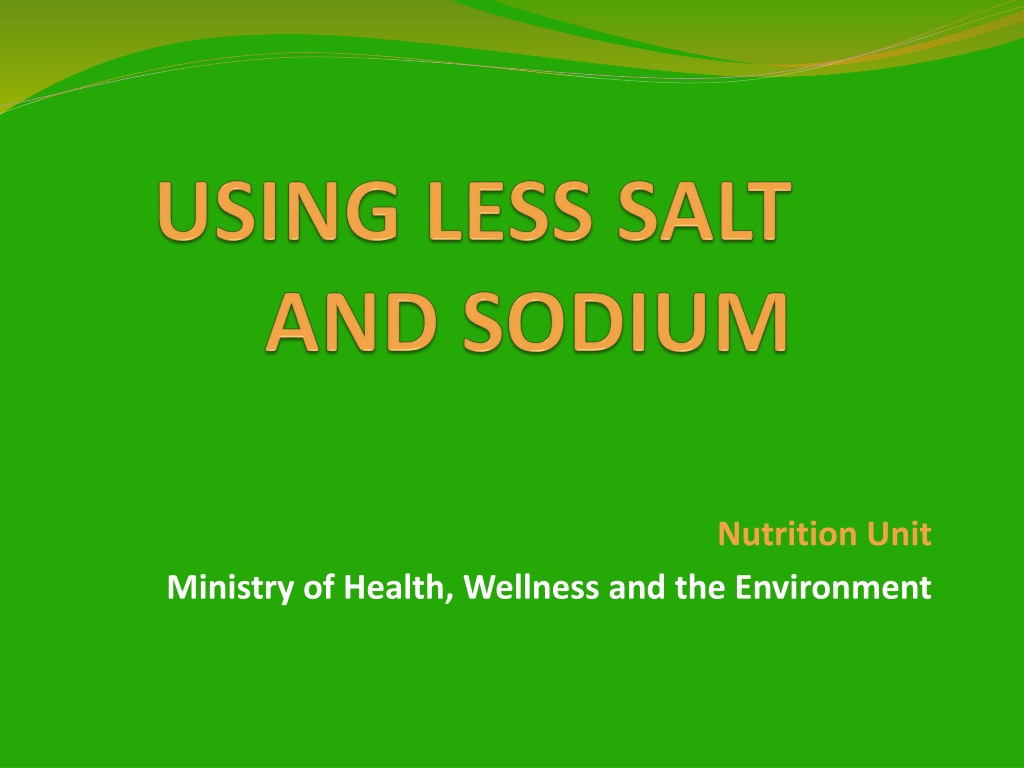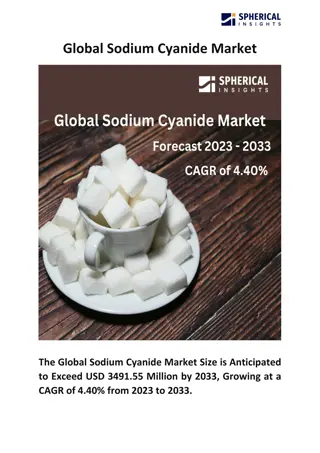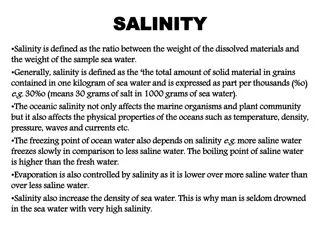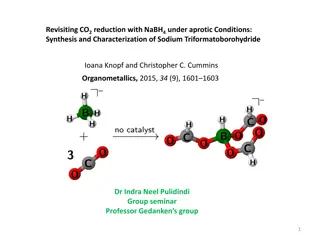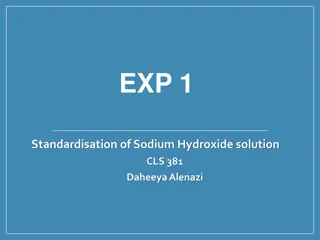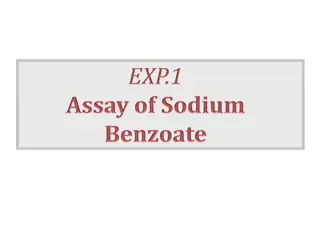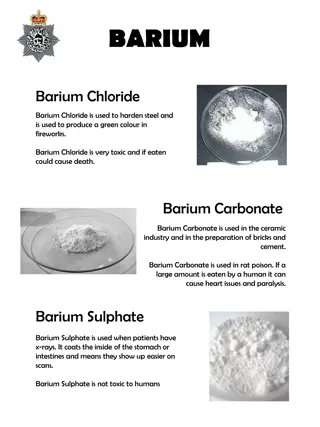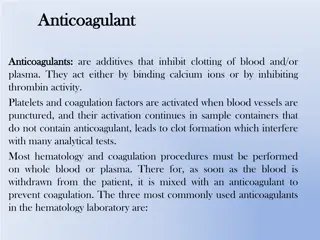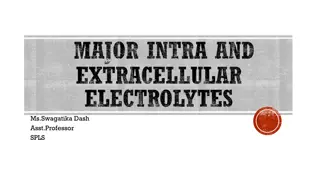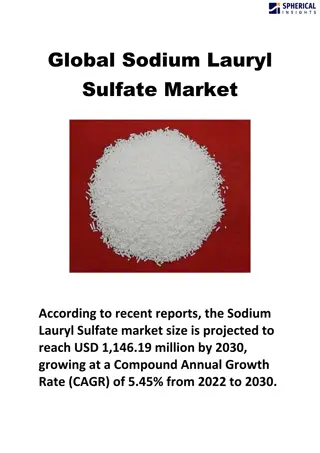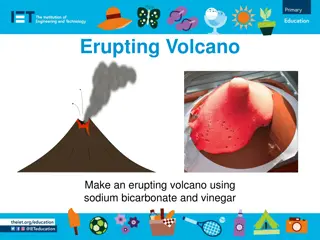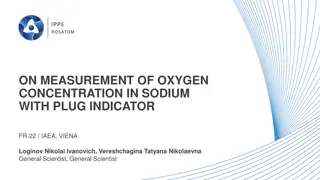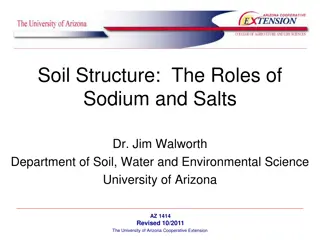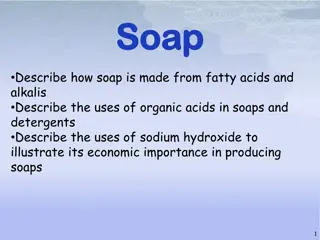Sodium - Understanding its Role in Your Health
Learn about the importance of sodium in the body, its functions, and the risks of consuming excessive amounts. Discover how sodium impacts health, including its role in maintaining fluid balance and nerve function. Find out ways to reduce salt intake and promote better overall health.
Download Presentation

Please find below an Image/Link to download the presentation.
The content on the website is provided AS IS for your information and personal use only. It may not be sold, licensed, or shared on other websites without obtaining consent from the author. Download presentation by click this link. If you encounter any issues during the download, it is possible that the publisher has removed the file from their server.
E N D
Presentation Transcript
Nutrition Unit Ministry of Health, Wellness and the Environment
NUTRITION AWARENESS WEEK in keeping with guideline No 6 of the NATIONAL DIETARY GUIDELINES of St. Vincent and the Grenadines this session will focus on using less salt and sodium. GUIDELINE # 6 When cooking use less salt and salted seasonings. Eat less salted foods and snacks.
Outline What is sodium Functions of sodium in the body Sodium needs Harmful effects of excess sodium Hidden salt and sodium Using less salt and sodium Using more potassium
What is Sodium? Sodium is the main positive ion (cation) in the fluid surrounding cells in the body. the main source of sodium in the diet is Common table salt or sodium chloride which is 40% sodium and 60% chloride
Functions of Sodium in the body Most of the body s sodium is in the blood and the fluid around cells. For good health our bodies need sodium to help: maintain red blood cells regulate and maintain fluid balance regulate and maintain acid-base balance Maintain normal nerve and muscle function the heart to beat normally
Sodium needs in the body Our bodies only need tiny amounts of sodium to function (200 to 500 milligrams) Sodium needs increase with increased sweating from hot days or heavy physical activity
BUT We consume far more salt and sodium than we need and this can harm our bodies
Harmful effects of excess sodium Too much salt in the diet can cause CARDIOVASCULAR DISEASE through raised blood pressure from fluid retention and build up in the body. Lead to STROKE AND HEART ATTACK
Harmful effects of excess sodium Too much salt in the diet can cause KIDNEY DISEASE by reducing their capacity to remove unwanted body fluid increasing the amount of protein in the urine Increasing formation of kidney stones
Harmful effects of excess sodium Too much salt in the diet can increase risk of STOMACH CANCER by increasing the growth and action of the bacterium Helicobacter pylori (H. pylori. ) Acting as an irritant and inflammatory agent on the stomach lining exposing it to cancer- causing agents (carcinogens)
Harmful effects of excess sodium Too much salt in the diet can DAMAGE BONE HEALTH by: increasing calcium levels in the urine Increasing calcium loss from bones Increasing the risk of bone demineralisaton and OSTEOPOROSIS
Using less salt and sodium is critical to controlling blood pressure, and reducing damage to heart, brain and kidney, stomach and bone health in our population
Maximum levels of SODIUM intake The daily recommended maximum level intake in healthy adults is 2 grams or less of sodium THIS equals about (5 grams) or one level teaspoon of table salt
SODIUM guide for hypertensives High blood pressure in most black Caribbean and elderly people tends to be sensitive to salt SO a maximum of 1 gram of sodium or one half teaspoon salt a day is recommended for hypertensives.
Dietary Sources of Sodium Unprocessed foods contain natural sodium in very small amounts (milk, meat, fish, poultry and eggs, some vegetables) Most processed and packaged foods are high in sodium, which is added to enhance taste and to extend shelf-life
Hidden salt and sodium Most salt in the diet is hidden in condiments and salted seasonings like stock cubes and bouillon MSG (monosodium glutamate) All purpose seasoning and onion and garlic salts ketchup, BBQ sauce, prepared mustard, salad dressing soy sauce, Worcestershire sauce
Hidden salt and sodium in processed meats like frankfurters, hot dogs , vienna and other sausages, pepperoni, salami, bacon, ham luncheon meat, corned beef salted pigtail, salt beef, salt pork
Hidden salt and sodium in cheeses and processed fish like Processed cheese and hard cheese like hard cheddar Salt fish ,
Hidden salt and sodium in processed, instant and fast foods like: canned soups and other foods instant or flavoured rice, instant noodles, potato mixes frozen french fries, pizzas Ready-to-eat frozen meals
Hidden salt and sodium in baked goods and some ready to eat foods like: Baked goods like muffins, crackers and quick breads Cake and pancake mixes Some ready-to-eat cereals
Hidden salt and sodium in salted snacks like: corncurls, salted chips Salted pretzels Snack crackers Salted nuts and salted popcorn
Hidden sodium In other forms of sodium used as food additives and preservatives like: Monosodium glutamate MSG) Baking powder & baking soda Sodium nitrates & nitrites
SODIUM CONTENT PER 100 GRAM (3 OUNCE) SERVING FOOD ITEM SODIUM CONTENT IN MILLIGRAMS (mg) BOUILLON OR STOCK CUBES 20,000 SALTED, DRIED CODFISH 8100 SALAMI 1850 PROCESSED CHEESE SPREAD 1650 SODA CRACKERS 1100 FRUITS , GROUND PROVISION, RICE, OATS 1-30 VEGETABLES 1-100
Reduce salt and sodium intake There are many ways to reduce salt and sodium intake: 1. Start by not adding more salt during seasoning or cooking food or at the table 2. Cut in half the amount of high sodium and salted seasonings used in food preparation 3. Limit the purchase and use of processed, canned and packaged foods.
Reduce salt in seasoning & cooking Use fresh and dried seasonings, herbs, spices like: chives, garlic, onion, ginger, sweet pepper, flavour pepper, hot pepper, paprika, cayenne pepper, pimento, fine and big leaf thyme, chadon beni, parsley, celery, sage, basil, rosemary, sweet marjoram, oregano, curry, saffron, cloves, cinnamon and allspice
Reduce salt in seasoning & cooking Use lime juice, vinegar, and salt/sodium-free seasoning blends to season and cook chicken, fish, and other meats to enhance food flavor and make them more tasty.
Reduce salt in seasoning & cooking COOK staple foods like green banana, plaintain, breadfruit, provisions , rice and pasta, peas and beans, vegetables without salt, salted seasonings and flavor with the fresh seasonings, herbs and spices
Reduce salt in seasoning & cooking Rinse foods canned in brine (salted water), such as tuna, sardines, and canned beans to remove some sodium
Shop to Reduce Salt and Sodium It is not possible to rinse or soak away the sodium in cheese, salami, frankfurters, sausages, pepperoni, bacon, ham, corned beef, luncheon meat and other deli meats SO Reduce intake of these foods to help control salt intake, particularly in persons who have been diagnosed with hypertension.
Shop to Reduce Salt and Sodium Buy fresh poultry, fish, and lean meat, rather than salted, smoked, canned or processed types.
Shop to Reduce Salt and Sodium Choose ready-to-eat breakfast cereals that are low in sodium. Buy less instant or flavored rice, pasta, muffins and quick bread made with baking powder, cereal mixes, and packaged cake mixes, which usually have added salt and/or sodium. Buy unsalted snacks like unsalted peanuts and popcorn instead of salted snacks
Shop to Reduce Salt and Sodium Buy fresh or plain frozen vegetables When available, buy low- or reduced-sodium or no-salt-added versions of processed foods that you use often. Buy less frozen dinners, pizza, canned soups or broths, and salad dressings these often have a lot of sodium.
Shop to Reduce Salt and Sodium Read labels on tins and packages for sources of sodium and for the sodium content per serving of the food. It is preferable to purchase foods with a sodium content of 140 milligrams or less per serving.
Use more potassium rich foods Potassium helps regulate fluid balance and blood pressure in your body low potassium levels may increase risk of raised blood pressure so increased intakes of foods rich in potassium are recommended Getting enough potassium may help lower your blood pressure.
potassium needs The World Health Organization (WHO) recommends MINIMUM potassium intake for healthy adults as follows: At least 3,510 milligrams (mg) daily This is even higher for hypertensives on the Dietary (DASH) diet At least 4,700 milligrams (mg) daily It is best to get potassium from food instead of supplements.
Use more potassium rich foods Try these potassium-rich foods: Potato: 926 mg Sweet potato: 540 mg Small banana: 467 mg Tomato: 400 mg 1/2 Avocado: 345 mg 1/2 cup cooked spinach: 290 mg Small orange: 237 mg
POTASSIUM CONTENT IN FOOD POTASSIUM CONTENT PER 100 GRAM (3 OUNCE) SERVING FOOD ITEM POTASSIUM CONTENT in milligrams (mg) BEANS AND PEAS 1300 NUTS 600 VEGETABLES (CABBAGE, SPINACH ) 550 FRUITS (RIPE BANANAS, PAWPAW) 300 COCONUT WATER 250
